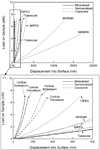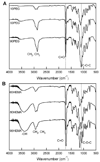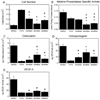The dependence of MG63 osteoblast responses to (meth)acrylate-based networks on chemical structure and stiffness
- PMID: 20510445
- PMCID: PMC2896827
- DOI: 10.1016/j.biomaterials.2010.04.033
The dependence of MG63 osteoblast responses to (meth)acrylate-based networks on chemical structure and stiffness
Abstract
The cell response to an implant is regulated by the implant's surface properties including topography and chemistry, but less is known about how the mechanical properties affect cell behavior. The objective of this study was to evaluate how the surface stiffness and chemistry of acrylate-based copolymer networks affect the in vitro response of human MG63 pre-osteoblast cells. Networks comprised of poly(ethylene glycol) dimethacrylate (PEGDMA; Mn approximately 750) and diethylene glycol dimethacrylate (DEGDMA) were photopolymerized at different concentrations to produce three compositions with moduli ranging from 850 to 60 MPa. To further decouple chemistry and stiffness, three networks comprised of 2-hydroxyethyl methacrylate (2HEMA) and PEGDMA or DEGDMA were also designed that exhibited a range of moduli similar to the PEGDMA-DEGDMA networks. MG63 cells were cultured on each surface and tissue culture polystyrene (TCPS), and the effect of copolymer composition on cell number, osteogenic markers (alkaline phosphatase specific activity and osteocalcin), and local growth factor production (OPG, TGF-beta1, and VEGF-A) were assessed. Cells exhibited a more differentiated phenotype on the PEGDMA-DEGDMA copolymers compared to the 2HEMA-PEGDMA copolymers. On the PEGDMA-DEGDMA system, cells exhibited a more differentiated phenotype on the stiffest surface indicated by elevated osteocalcin compared with TCPS. Conversely, cells on 2HEMA-PEGDMA copolymers became more differentiated on the less stiff 2HEMA surface. Growth factors were regulated in a differential manner. These results indicate that copolymer chemistry is the primary regulator of osteoblast differentiation, and the effect of stiffness is secondary to the surface chemistry.
2010 Elsevier Ltd. All rights reserved.
Figures





Similar articles
-
Incorporation of phosphate group modulates bone cell attachment and differentiation on oligo(polyethylene glycol) fumarate hydrogel.Acta Biomater. 2012 Apr;8(4):1430-9. doi: 10.1016/j.actbio.2011.12.031. Epub 2012 Jan 8. Acta Biomater. 2012. PMID: 22277774 Free PMC article.
-
Response of MG63 osteoblast-like cells to titanium and titanium alloy is dependent on surface roughness and composition.Biomaterials. 1998 Dec;19(23):2219-32. doi: 10.1016/s0142-9612(98)00144-6. Biomaterials. 1998. PMID: 9884063
-
Osteoblasts exhibit a more differentiated phenotype and increased bone morphogenetic protein production on titanium alloy substrates than on poly-ether-ether-ketone.Spine J. 2012 Mar;12(3):265-72. doi: 10.1016/j.spinee.2012.02.002. Epub 2012 Mar 15. Spine J. 2012. PMID: 22424980 Free PMC article.
-
Synthesis and characterization of butyl acrylate-co-poly (ethylene glycol) dimethacrylate obtained by microemulsion polymerization.Des Monomers Polym. 2020 Mar 16;23(1):40-49. doi: 10.1080/15685551.2020.1739506. eCollection 2020. Des Monomers Polym. 2020. PMID: 32284706 Free PMC article. Review.
-
Cellular and molecular effects of growth hormone and estrogen on human bone cells.APMIS Suppl. 1997;71:1-30. APMIS Suppl. 1997. PMID: 9357492 Review.
Cited by
-
Sensing and modulation of invadopodia across a wide range of rigidities.Biophys J. 2011 Feb 2;100(3):573-582. doi: 10.1016/j.bpj.2010.12.3733. Biophys J. 2011. PMID: 21281571 Free PMC article.
-
Fabrication of 3D Scaffolds with Precisely Controlled Substrate Modulus and Pore Size by Templated-Fused Deposition Modeling to Direct Osteogenic Differentiation.Adv Healthc Mater. 2015 Aug 26;4(12):1826-32. doi: 10.1002/adhm.201500099. Epub 2015 Jun 29. Adv Healthc Mater. 2015. PMID: 26121662 Free PMC article.
-
Spatiotemporally Controlled Photoresponsive Hydrogels: Design and Predictive Modeling from Processing through Application.Adv Funct Mater. 2020 Aug 7;30(32):2000639. doi: 10.1002/adfm.202000639. Epub 2020 Jun 18. Adv Funct Mater. 2020. PMID: 32802013 Free PMC article. Review.
-
A Patterned Butyl Methacrylate-co-2-Hydroxyethyl Acrylate Copolymer with Softening Surface and Swelling Capacity.Polymers (Basel). 2019 Feb 9;11(2):290. doi: 10.3390/polym11020290. Polymers (Basel). 2019. PMID: 30960274 Free PMC article.
-
Osteogenesis-Related Behavior of MC3T3-E1 Cells on Substrates with Tunable Stiffness.Biomed Res Int. 2018 Nov 1;2018:4025083. doi: 10.1155/2018/4025083. eCollection 2018. Biomed Res Int. 2018. PMID: 30515396 Free PMC article.
References
-
- Adden N, Hoffmann A, Gross G, Windhagen H, Thorey F, Menzel H. Screening of photochemically grafted polymer films for compatibility with osteogenic precursor cells. J Biomater Sci, Polym Ed. 2007;18(3):303–316. - PubMed
-
- Boyan BD, Lohmann CH, Dean DD, Sylvia VL, Cochran DL, Schwartz Z. Mechanisms involved in osteoblast response to implant surface morphology. Annu Rev Mater Res. 2001;31:357–371.
-
- Engler AJ, Sen S, Sweeney HL, Discher DE. Matrix elasticity directs stem cell lineage specification. Cell. 2006;126(4):677–689. - PubMed
-
- Khatiwala CB, Peyton SR, Metzke M, Putnam AJ. The regulation of osteogenesis by ECM rigidity in MC3T3-E1 cells requires MAPK activation. J Cell Physiol. 2007;211(3):661–672. - PubMed
Publication types
MeSH terms
Substances
Grants and funding
LinkOut - more resources
Full Text Sources

